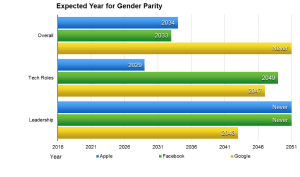Women in Leadership
Women in Leadership – Development Programs
Research Reveals
The issue: While a McKinsey report, “The Power of Parity,” April 2016, projects an increase of up to $4.3 trillion in 2025 for US GDP as a result of gender parity, top high tech companies (Apple, Facebook, Google, Microsoft, Twitter) currently report in their Y-Y EEO-1 annual filings a paltry increase of only 1-3 percentage points year to year. “What does this mean?” Without more substantial efforts, women currently at even the most progressive high tech companies who aspire to leadership roles will NOT experience a “level playing field” in their career lifetime.
Moreover, in a recent ExecCatalyst poll in Silicon Valley, 80% of women surveyed responded that being a women created more disadvantages rather than advantages in the workplace. Since women represent only 20% of graduates in engineering and computer science (BestColleges.com), high tech companies face a seemingly insurmountable challenge – how to strengthen their leadership teams to become more globally competitive e.g. breaking out of insular “groupthink?”
ExecCatalyst is focused on helping individuals, teams and companies to break through this headwind. Through 1-1 coaching and team workshops, we help your high potential leaders move beyond the theories of leadership and navigate real obstacles. At an institutional level, we help to build a diverse people and management operating system that leads to better products due to closer affinity to customers.
Leadership Development:
Success in today’s competitive high-tech environment calls for exceptional leaders to be ready and fully capable of driving change and delivering breakthrough results. This means managing for success in complex situations and fostering real-time alignment between people, performance, and project success. ExecCatalyst provides customized “Women in Leadership” workshops and targeted 1-1 coaching around topics including (not limited to):
“Advantages” – how to leverage:
- Being visible
- Perceived approachability
- Access to established/ formal development opportunities
“Disadvantages” – how to deal with:
- Not in the “boys club” – how men think and view women in the work place
- Stereotype of women behaviors i.e. “too feminine” or “too masculine”
- Prove it again – having to provide more competence than men
Corporate Initiatives:
Companies that only focus on first-step diversity efforts (e.g., hiring, promoting, and training diverse talent) without aligning an overall performance strategy, risk internal cultural conflict that will diminish, not enhance, corporate performance and returns. For example, though well intentioned, mandatory “unconscious bias” training is a double-edged sword. While sensitizing employees, it may also create resentment for employees who may interpret this as “diversity indoctrination” rather than constructive engagement. Each company must understand and address their specific root causes, otherwise investments in initiatives and programs will be wasted.
While many companies have taken on “hiring” initiatives and some have started preliminary steps to address “promotion” imbalances, ExecCatalyst focuses on companies that are striving to build a diverse corporate eco-system for both organizational survivability and a competitive advantage. Engagements include (not limited to):
- Gender Parity Assessment – employee surveys and interviews to gauge sentiment e.g. where your organization lies on the wide-spectrum of gender initiatives and correlating that to your company’s goals and measurement instruments.
- Leadership Strategy – define an organizational strategy and plan for identifying and developing leaders i.e. from the “right thing to do” to a proactive and intentional approach. We utilize tools (Hofstede, Appreciative Inquiry) to instill a corporate culture that not only respects, but leverages diverse talent.
- Rewire Internal Systems – address institutional bias. For example, Promotion System – implement a system to assess, identify and promote your best talent rather reactive promotions based on achieving metrics-based targets.

